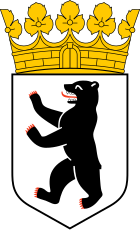»
»
»
Berlin
Berlin

Berlin is the city with around 3.7 million inhabitants, the most populous and with 892 square kilometers the largest municipality in Germany and the most populous city in the European Union.[4] With 4123 inhabitants per square kilometer, the city has the third highest population density in Germany. Almost 4.7 million people live in the Berlin agglomeration, and around 6.2 million in the Berlin-Brandenburg capital region. The city-state consists of twelve districts. In addition to the rivers Spree, Havel and Dahme, there are smaller watercourses as well as numerous lakes and forests in the city area. In 1237 and 1244 the neighboring towns of Alt-Kölln and Alt-Berlin were first mentioned in today's district of Mitte. The double city was founded as a trading center and rose to become an important economic center in the Middle Ages. In its almost 800-year history, Berlin has functioned as the capital of Mark Brandenburg, Prussia and Germany. In the course of the 19th century, Berlin established itself as an international city with a lot of people moving in to the world's fourth largest city, with Berlin Classic as a cultural location, as the center of European Enlightenment, and as an important industrial and scientific location. After the end of the Second World War, the city was subject to four-power status in 1945; From 1949 East Berlin functioned as the capital of the socialist autocracy of the German Democratic Republic, while West Berlin was closely attached to the free-democratic Federal Republic. With the fall of the Berlin Wall in 1989 and German reunification in 1990, the two halves of the city grew together again and Berlin regained its role as the all-German capital. Since 1999, the city has been the seat of the federal government, the federal president, the German Bundestag, the Bundesrat and most federal ministries, numerous federal authorities and embassies.
 Berlin is the city with around 3.7 million inhabitants, the most populous and with 892 square kilometers the largest municipality in Germany and the most populous city in the European Union.[4] With 4123 inhabitants per square kilometer, the city has the third highest population density in Germany. Almost 4.7 million people live in the Berlin agglomeration, and around 6.2 million in the Berlin-Brandenburg capital region. The city-state consists of twelve districts. In addition to the rivers Spree, Havel and Dahme, there are smaller watercourses as well as numerous lakes and forests in the city area. In 1237 and 1244 the neighboring towns of Alt-Kölln and Alt-Berlin were first mentioned in today's district of Mitte. The double city was founded as a trading center and rose to become an important economic center in the Middle Ages. In its almost 800-year history, Berlin has functioned as the capital of Mark Brandenburg, Prussia and Germany. In the course of the 19th century, Berlin established itself as an international city with a lot of people moving in to the world's fourth largest city, with Berlin Classic as a cultural location, as the center of European Enlightenment, and as an important industrial and scientific location. After the end of the Second World War, the city was subject to four-power status in 1945; From 1949 East Berlin functioned as the capital of the socialist autocracy of the German Democratic Republic, while West Berlin was closely attached to the free-democratic Federal Republic. With the fall of the Berlin Wall in 1989 and German reunification in 1990, the two halves of the city grew together again and Berlin regained its role as the all-German capital. Since 1999, the city has been the seat of the federal government, the federal president, the German Bundestag, the Bundesrat and most federal ministries, numerous federal authorities and embassies.
Berlin is the city with around 3.7 million inhabitants, the most populous and with 892 square kilometers the largest municipality in Germany and the most populous city in the European Union.[4] With 4123 inhabitants per square kilometer, the city has the third highest population density in Germany. Almost 4.7 million people live in the Berlin agglomeration, and around 6.2 million in the Berlin-Brandenburg capital region. The city-state consists of twelve districts. In addition to the rivers Spree, Havel and Dahme, there are smaller watercourses as well as numerous lakes and forests in the city area. In 1237 and 1244 the neighboring towns of Alt-Kölln and Alt-Berlin were first mentioned in today's district of Mitte. The double city was founded as a trading center and rose to become an important economic center in the Middle Ages. In its almost 800-year history, Berlin has functioned as the capital of Mark Brandenburg, Prussia and Germany. In the course of the 19th century, Berlin established itself as an international city with a lot of people moving in to the world's fourth largest city, with Berlin Classic as a cultural location, as the center of European Enlightenment, and as an important industrial and scientific location. After the end of the Second World War, the city was subject to four-power status in 1945; From 1949 East Berlin functioned as the capital of the socialist autocracy of the German Democratic Republic, while West Berlin was closely attached to the free-democratic Federal Republic. With the fall of the Berlin Wall in 1989 and German reunification in 1990, the two halves of the city grew together again and Berlin regained its role as the all-German capital. Since 1999, the city has been the seat of the federal government, the federal president, the German Bundestag, the Bundesrat and most federal ministries, numerous federal authorities and embassies.
.png)